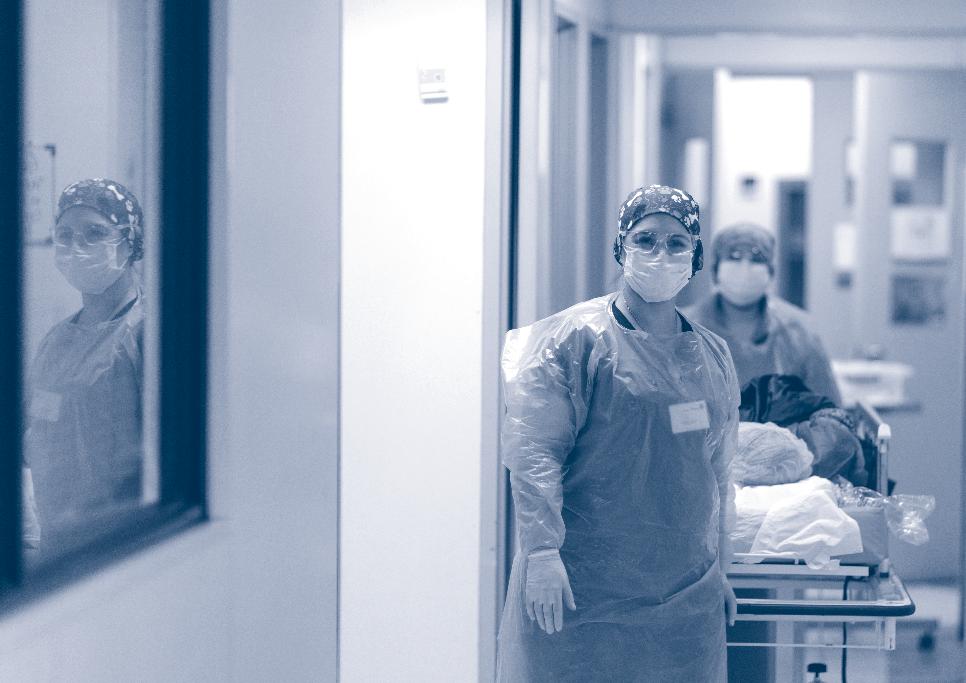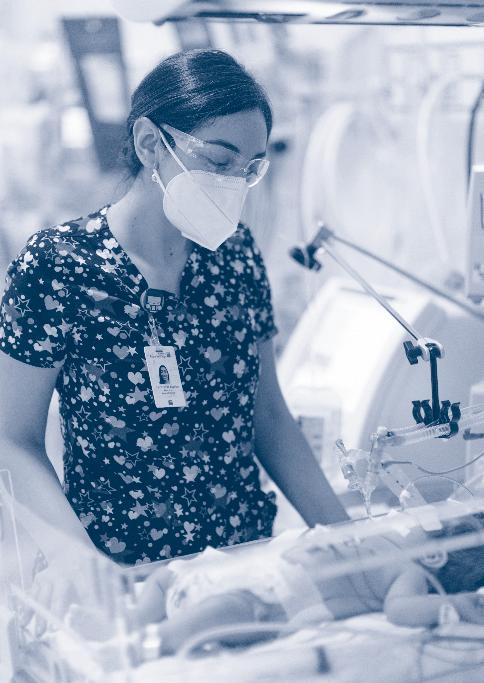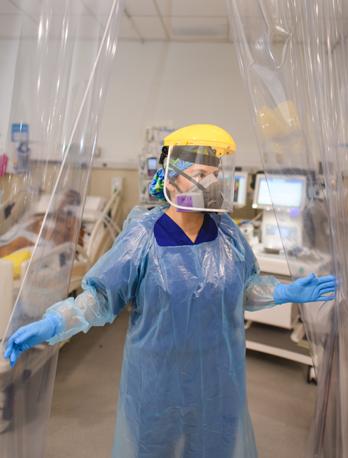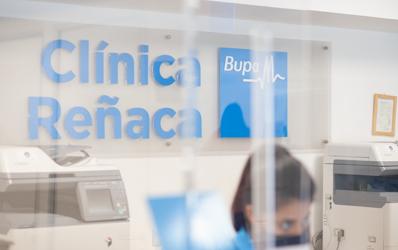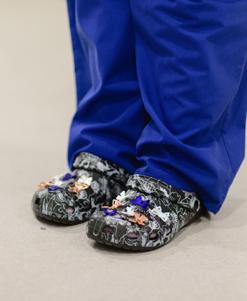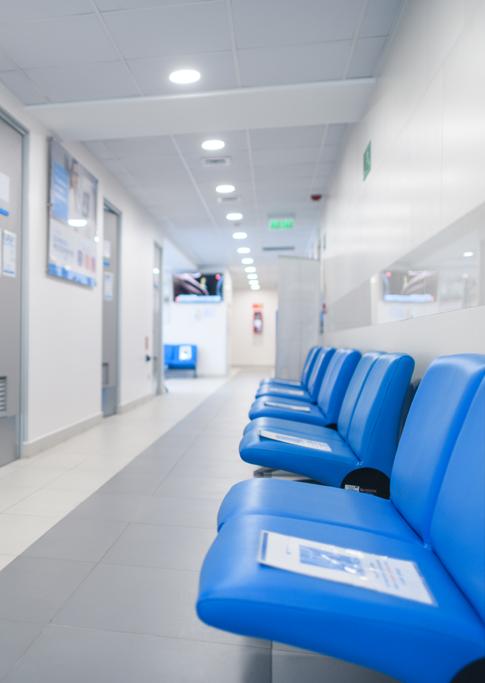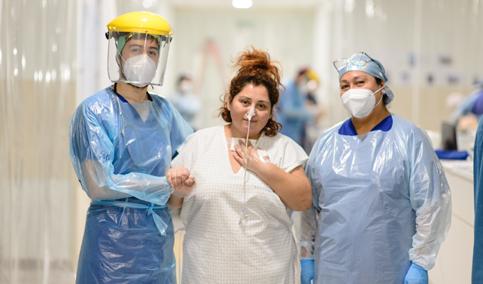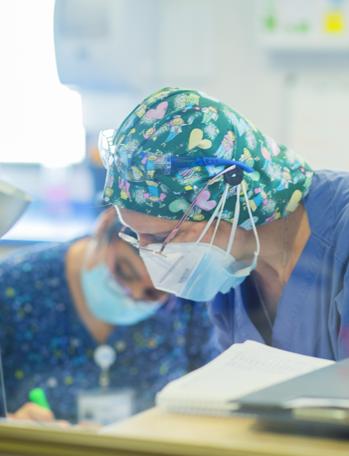
8 minute read
I got Covid
In human terms, it has been difficult to handle our personal situations and support all the people who need us. It is a real challenge to be a flexible leader. But we chose this job and looking after patients is our life, and this strengthens us and helps us to grow as professionals. Another challenge we have faced is having enough staff to cope with the demand. We had to train a lot of new people as well as informing and reassuring our employees and patients on our care measures. We are still on a journey, and that means insisting daily on the preventive measures, because patients get relaxed. We are still training and raising awareness of the rest of the staff. Every day we learn new ways of looking after patients well and being safe and giving quality care. Another important thing during the pandemic has been resources, especially ppe. The key is estimating and managing efficiently. The clinical protocols are important, defining the types of PPE for each different function. In the first stages, everyone wanted to use all the protective gear, even more than the evidence and the guidelines suggested, and that was something we had to deal with. Our aim was to involve the whole medical centre team, so that they understood and adhered to the changes and the new care model for Covid times. The first thing was dealing with appointments, samples and imaging, then safe procedures for clinical processes. We had to sort out the journeys for Covid and non-Covid patients in each network medical centre, with the peculiarities of each. We set up triage in the entrance zones so that we could direct patients in accordance with their needs and clinical condition. We also put up signs in all the areas giving information about the protective measures and the care flows, to deal with the growing number of patients. Then, gradually, we started to bring things back to normal, with demand challenging us to open new provisions and procedures under new standards. Our role as lead nurses in medical centres is to be proactive in taking on board and making the different procedures, standards and checks work. There were more and more as the pandemic went on. We also had to make sure all the safety procedures were implemented as soon as they were brought in, make the changes, make sure they were followed all the time, and that nobody broke the rules, because that would put our patients and/or staff at risk. That meant a lot more work every day. To do all that, we needed to work together with different units in the centre, both administrative and clinical. It was important that we made good decisions that ensured continuity and a good level of care and excellent quality. Managing, directing work teams in a dynamic and changing context, the product of a pandemic like no other the world had ever known, required comprehensive leadership. It was a challenge to our resilience and capacity to adapt to constant change. The role of lead nurses in medical centres, put in charge of epidemiology, has contributed to the traceability of cases and the correct handling of tracing contacts. This new role made our daily administration tasks more difficult, whilst we juggled this epidemiological function with the multiple nursing tasks we were handling and in which we must maintain the highest levels of quality and safety. Thanks to our teamwork, we have been able to maintain quality and continuity of care during the pandemic and make an important contribution nationally, becoming an indispensable organization because of the large number of people we attend to and who put their confidence in us.�
We have transformed ourselves to take better care of and save more people
carla alarcón Director of Nursing at Bupa Chile Hospitals
We want to make our teams’ stories heard, put them in the spotlight, make sure they become a legacy. This book is a way of recognising the work and dedication of nursing and midwifery teams, which can’t really be fully measured. We started planning 2020 as the International Year of the Nurse and the Midwife, as declared by the WHO. However, like the rest of the world, we had to adapt quickly to the new context the pandemic had created, which has meant our profession has been more in the spotlight than ever.
Working with Spain
In March, the first news started to break. We had to quickly change our focus and plan how to fight the pandemic. We got a lot of information from Spain, because the pandemic hit there before it did here. Working committees were set up between the two countries, at which each Sanitas hospital would report on their situation. They would share strategies and success stories. The idea was to learn from the experiences of their teams and copy good practice and procedure, bringing that into line with the standards dictated by the Ministry of Health in Chile. From that foundation, we would draw up our own protocol. CHILE
Personally, I had a lot of contact with Laura Alvargonzalez, Director of Nursing at La Moraleja, one of the Sanitas hospitals in Madrid. I remember something she told me: buy ppe equipment (personal protection equipment such as masks, gloves, disposable boots, etc.) to stop the spread, because it will never be too much. Looking after your staff is the key to success. Being part of a multinational organisation and the time it took for the pandemic to hit Chile, later than Spain, helped us prepare to fight it better. We saw how nowhere in the world was prepared for such a crisis, but I think Bupa Chile was able to plan quickly and well.
Ensuring we had staff and equipment
Because of the scale of the crisis, we had to have a joint vision that then moved into specific strategies, to deal with different situations. I think that is illustrated when we think about the planned purchase of PPE, because we needed to make sure we had enough stock to meet the projected increase in the number of beds, with occupation projected at around 100% and over 80% of that likely to be Covid patients. Another important factor was having enough staff, because we would have people off sick with the disease or in quarantine because of contact they had had with infected people. We estimated an increase in staff based on two variables: standard care ratios and back up teams to cover sickness because of infection or quarantine, so we estimated a rise in 30% in the number of care staff. With that information in hand, the challenge was to recruit staff in a context where all healthcare providers were in the same boat and the market didn’t have enough trained professionals. So, we had to find ways to be more competitive and attractive for recruitment.
Emergency training
As there were not enough nurses with experience in intensive care unit, we brought in training in caring for patients in critical units and training in specific Covid protocol. We created a training programme with five modules: General care of Critical Patients, Haemodynamics, Respiratory Pathology, Pharmacology and other systems focused on the main objectives in caring for critical patients, using the existing Bupa Chile platform which all our clinics have access to across the country. We also set up assessment and built a network of delegates from all the clinics to incorporate, with our contracting teams, all the people coming in from whichever modality. It was a success, and we hired and trained over 1000 people in these specific capacities.
The platform allowed us to have a system of control and followup of all the clinics and we were able to get feedback on advances or partial results, so that we could strengthen and encourage learning. That way we prepared our teams in advance, from the simplest to the most complex units.
Safety for all our patients
We prepared well, from a technical point of view, but it was not enough, if you take into account the many aspects, such as ensuring safety for all those people who needed emergency medical attention or had pressing needs other than Covid. So, plan in hand, and working together with operations, customer care, marketing, hai (Healthcare acquired infections), Quality and others, we drew up care flows to section off emergency areas. It was hard work, but we did it together. We created two emergency zones: one for respiratory patients and the other for general consultations. We also sectioned the outpatients area with circulation flows, corridors and lifts. We put up signs for each type of care, had lines on all the floors, messages on our digital platforms and training for our teams so that they could guide patients. The sectioning off of flows and areas also took into account the hospital floors in respiratory areas and “clean” areas, as well as including a ward for surgical emergencies for positive patients or suspected Covid patients with exclusive anaesthesia machines with a double filter, amongst other measures.
The experience of clinical management
The pandemic gave us the opportunity to put to the test and show our profession’s values and the people working in healthcare. That, as well as expert knowledge, allowed us to show how versatile nursing and midwifery is, as a career. It clearly has multiple roles: care, or primary care for patients with complex needs, which needs specialised technical and professional knowledge, administration and control of resources to ensure availability and appropriate use of critical resources, the role of education for patients, families and employees, and the need to train people with the necessary knowledge and skills to meet the demand for healthcare. We should also point out the role of clinical management, because during the pandemic we had to set up 24/7 shifts of nurses and resident midwives, to manage the beds, giving the internal and external requirements. That is because the Ministry of Health decree meant we were part of a national integrated network of care providers. We had to report our capacity and the availability of ventilators on a daily basis, so that they could send patients from other places, and that required a lot of fine-tuning.

